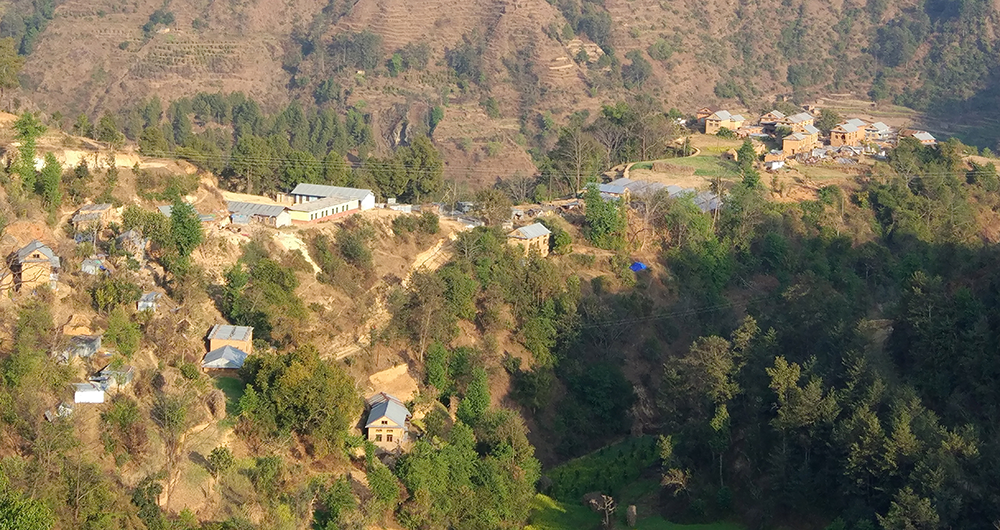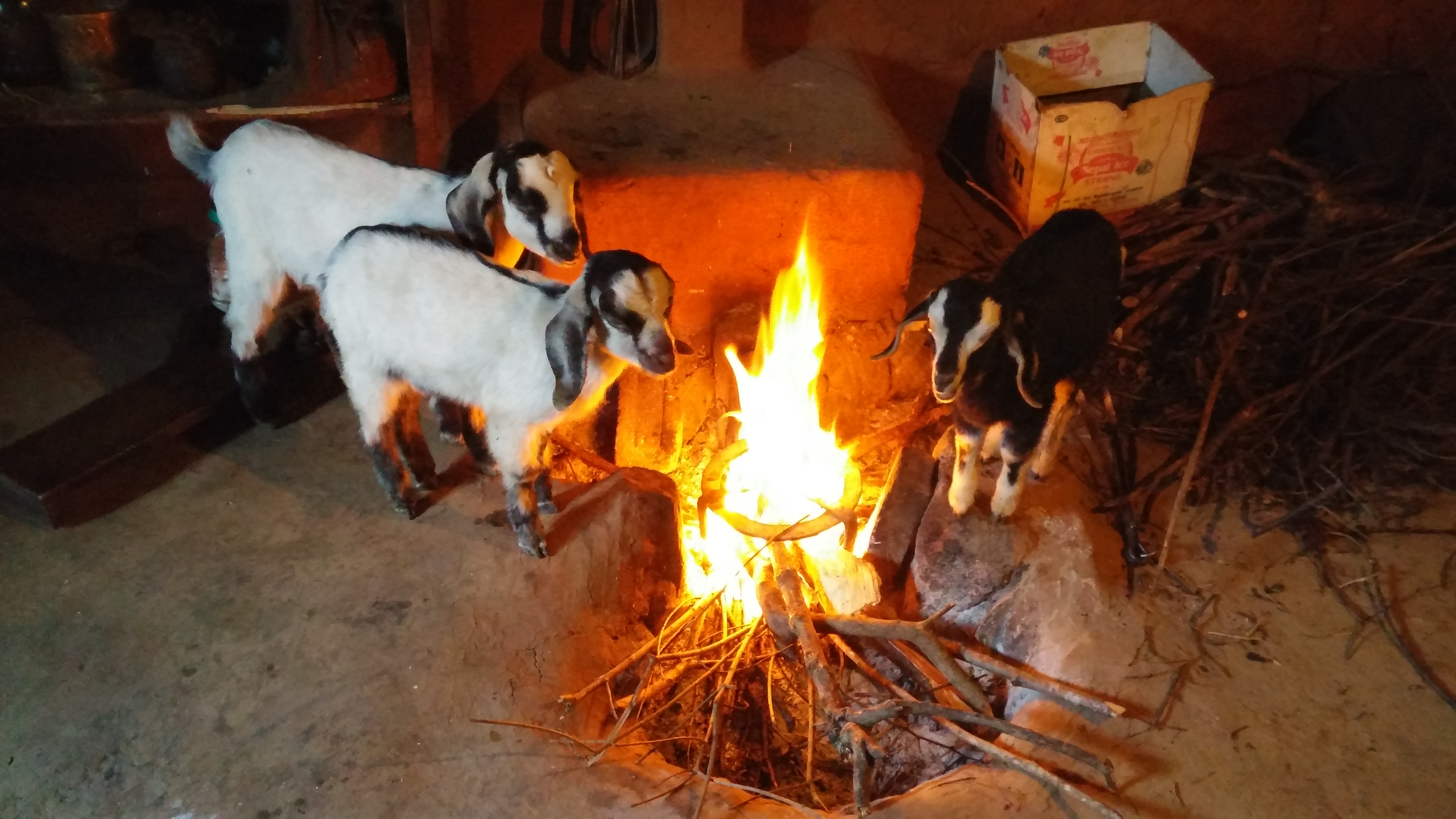
An aerial view of Sano Gaun, Nepal. Photo courtesy of CRT-N.
In cities, villages, and towns throughout the world, university researchers seek to bring innovations to the lives of those in developing countries. They reach out a humanitarian hand, hoping to elevate the wellbeing of people.
However, these development projects don’t always go as planned. Infrastructure is neglected, technology is discarded, or lifestyle changes fail to materialize. Why?
Tami Bond, Professor of Civil and Environmental Engineering and Director of the Center for Applied Collaboration on Human Environments (CACHE) at the University of Illinois at Urbana-Champaign has an idea why.
“So often when researchers come into a village, they’ve already looked at a profile of the place and decided what the problem is there, and they’ve pulled a perfect solution off the shelf to solve it. And although you do a lot of work to tailor it to the people’s needs to make sure it will get adopted, you’ve already decided what is best, you know? And no matter how well designed, it may inherently have some built-in markers for failure,” she said.
“I think there is a mismatch between the altruistic tug we researchers feel to use our expertise to help — which determines what we can provide — and what is actually needed by the people we want to help.”
To test her hypothesis about building a better development project, Bond and CACHE have begun a new initiative in partnership with researchers at Illinois, Johns Hopkins University, and the Centre for Rural Technology in Nepal (CRT-N), a non-governmental organization.
It’s called The emPOWER Collective — and its goal is to be extremely purposeful about taking a new approach to build a grassroots effort within the eastern Nepalese village of Sano Gaun to discuss energy concerns. The researchers will place outside expertise at the service of village residents.
“We’ve chosen a theme of energy because that’s my expertise area, “ Bond said. “But then we haven’t any idea what energy challenge we are going to try to solve. What we’d like to do is have a conversation with the village about energy, and energy solutions, use our expertise to communicate to them what their options might be, and together choose what might be the most appropriate solutions for them.”
It seems like common sense to have that kind of conversation, but Bond explains that it isn’t that simple.
“For decades, Nepal has been flooded with development work —it’s already friendly to tourists and it’s easy to get a visa to go there — and so it’s hard to find a place that has never been touched by some kind of development work. So, the Nepalese people have really adopted the mindset of ‘You are an outsider, and you are here to operate in a certain mode. We’re just going to listen to what you want to say,’ ” she said.
“So, if we offer them a technology — just for example a clean cookstove — even if it’s not what they want, they haven’t developed the notion that you can say, ‘That’s not really what I want; I’d rather have something else,’ or ‘I wouldn’t use that if you gave it to me.’ They’ll answer the questions they are asked. And so we are trying to empower them with that ability first and then proceed to talk about energy later.”
A Scouting Mission
Before any empowerment or conversations can take place, however, the CRT-N team needed to that Sano Gaun would be receptive to the ideas of international experts at all.
In January, CRT-N Senior Officer Ashma Vaidya and Programme Officers Shovana Maharjan and Subas Lamichhane conducted a “rapid assessment” of the village — a few days’ tour of the town and interviews with residents in an effort to scan for red flags that may indicate it would not be an appropriate place to conduct a pilot of the “Empowerment-then-Action” model for development work.
Bond traveled alongside the CRT-N team to try to lend an extra perspective during the assessment.She toured villagers’ homes and farms and observed and assisted with informal interviews about energy needs. Her main role, as she saw it, was to notice the things that may seem inconsequential to her Nepalese teammates, who work so often in villages like Sano Gaun that they sometimes skip the most mundane and commonplace aspects. Those little details may not seem significant to a native, but make a world of difference to a researcher, Bond said. “A fish doesn’t know it’s in water, right?”
“I got up one morning, and I saw women coming down the hill with these little red tied bags of goods. [I found out] they go visit the milk truck when it stops and get paid for their milk, and they can buy stuff,” she said. “That is a huge difference compared to a village that is cut off and doesn’t have access to any kind of outside goods. That little cash income is important because it changes the flavor of what those people use, and it helps me plan how to engage with them.”
In the end, team members identified several hurdles that would make running a pilot program difficult. But they also recognized they’d find similar levels of negatives in any other village, said Bond.
“We’ve decided to go ahead,” she said. “The purpose of the pilot is work out the bugs — and there are going to be lots of bugs. The first being that we have to convince people, especially the women, to engage in empowerment training when there’s no obvious outcome. We are seemingly waltzing in to say, ‘Hi, I just want to empower you. Would you like to engage in self-help training?’ We find that people don’t want to take time for themselves without a clear benefit beyond themselves — otherwise the time away from the house and family and could look selfish.”
Besides Bond, Vaidya, and Maharjan, The emPOWER Collective team comprises Mary Arends-Kuenning, Professor of Agricultural and Consumer Economics at Illinois; CRT-N’s Lachana Shresthacharya; and from Johns Hopkins University Anita Shankar, Medical Anthropologist.
CACHE is supported by the Institute for Sustainability, Energy, and Environment (iSEE) at Illinois, as well as the College of Engineering and the Department of Civil and Environmental Engineering.
Life in Sano Gaun
The village of Sano Gaun (English translation: “small village“) is one of three villages in the Balthali Village Development Committee Ward in the larger Kavre district of Nepal.
The bulk of the town sits on a fairly steep hill with a river at the bottom of a valley. The more than 100 residents support themselves through farming, each home having a garden to grow grains, vegetables, and citrus fruits to feed the family. Almost every household has one or more domesticated farm animals supplying milk and manure. Almost all of what is grown and made in the village is consumed in the village.
The river at the bottom of the valley is the main water source for local agriculture. Previously, a CRT-N project provided a Hydram pump to carry water part of the way up the hill to make it easier to use for irrigation.
Although the village has an access to the national electricity grid and road, firewood remains a primary source of energy for cooking family meals and animal feed, space heating, and water boiling (in the winter).
Discussions with women revealed that although they take the lead in making minor household decisions, men (fathers, husbands or adult sons) are in charge of financial and major household decisions.






